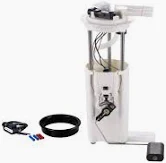If an electric fuel pump fails, the cause can be attributed to a number of factors which range from electrical malfunctions or contamination in The Fuel. Blown a Fuse or Faulty Relay DEBUG_SANITIZE_BRANCHcache:INFO Your fuel pump is electric, meaning it needs power to work and this comes from a relay or fuse. If the component that supplies power has failed in either case then you need to replace it so your Bora can get back on the road. In fact, electrical issues cause 30% of fuel pump failures. The first thing to do when this happens is check the fuse box of your vehicle for a blown fuse or relay that is not working properly.
Also, low fuel pressure due to a restricted/opened fuel filter. Fuel filters collect the debris and filth present in the fuel, resulting with time to a diminished flow of fuel towards pump that can make it fail or work abnormally. A filter that is clotted or blocked can show the same symptoms as a bad pump (i.e. poor acceleration, engine sputtering and there will be an issue when you go to start it). Depending on the driving you do your filters should be changed every 20,000 to 30,000 miles.
Whatever the issue, fuel contamination will also affect an electric pump. Because of this, water, dirt or rust particles can get into the fuel system causing damage to one or both of them which decreases their ability to pressurize the fuel. The New York Times, for example, said that if fuel quality was bad enough to reduce pumps' efficiency by 15 percent it could force them into operating-out-of-specification states resulting in poor instrument performance or disabling some DirecTV airlines from being able to throttle at all. Similarly, when you drive your car around with very little gas in the tank, it will cause a pump to overheat because the fuel is used as a coolant for the unit. Taking your car to always run on less than a quarter of the tank may reduce the life of pump drastically.
Fuel pressure regulator: in some cases the fault might be due to a malfunctioning fuel pressure regulator. This part regulates pressure in the fuel system and, therefore enables to make certain that the pump is continually feeding gasoline on your engine. A badly worn gasket in the regulator can cause excessive or lowered pressure causing an array of other issues such irritable engine roughness and knocking poor fuel economy or loss in power. Many times a simple high quality repair process in changing out the faulty pressure regulator can correct any problems without replacing the entire pump.

This could be due to corrosion on electrical connections. When water ends up in fuel many years and miles on down the road, it corrodes the connectors which supply power to this pump and finally either one or both of these little piggies go missing voltage for an efficient operation. Testing The Fuel Pump Circuit For PowerUsing a multimeter to test the electrical continuity of the fuel pump circuit will tell you if your lack of power is behind this problem.
Finally, normal wear and tear could have exhausted the pump; if your car has more than 100k on it this is the likely culprit as an electric fuel pump's lifespan falls between seventy-five to one hundred thousand miles. It may not make its characteristic hum when turning on the ignition, this could be a telltale sign that it has mechanically failed.
To read up some more on how to diagnose or replace your Electric Fuel Pump, click here =>Electric Fuel Pump and select from the long list of specific replacement options for you vehicle as well as troubleshooting tips.